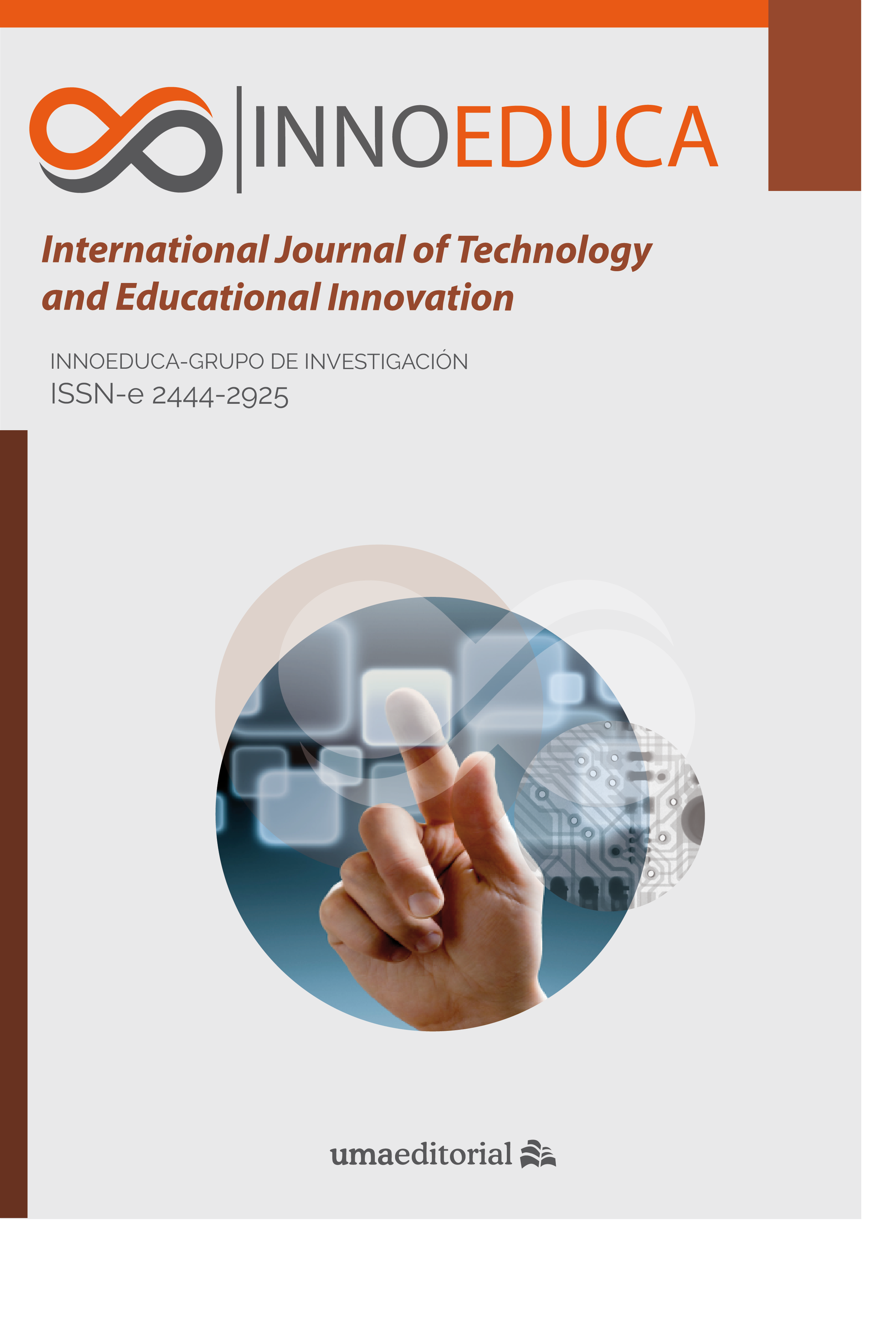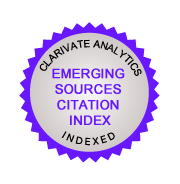Fusionando la realidad aumentada en la educación bilingüe y ESL: Percepciones de futuros maestros
DOI:
https://doi.org/10.24310/innoeduca.2021.v7i1.9823Keywords:
augmented reality, teacher education, bilingual education, ESL, immersive technologiesAbstract
In recent years there has been an increased interest by Teacher Education programs to train its pre-service teachers with immersive technologies. This had led to a greater boom and exploration of teaching possibilities of these technologies, especially with augmented reality and its integration to the bilingual and ESL classroom. The following article presents a recent study that was conducted at Texas Woman’s University with n=27 bilingual and ESL pre-service teachers. It served as a pilot and sought to determine pre-service teachers' perceptions on the strengths and limitations in the use of augmented reality for the bilingual and ESL classroom. It also sought to provide an understanding of potential mobile applications, educational implications and activities for the classroom. The study used a qualitative method following an exploratory design and integrated a content analysis. The findings indicated that the participants view AR as a strength to keep students engaged and motivated. On the other hand, access to AR technology was perceived as a limitation. The integration of AR applications such as Quiver and HP Reveal along with the integration of Culturally Relevant Teaching (Gay, 2013) supported the creation of activities (e.g., AR walls and class demonstrations) that were perceived by pre-service teacher candidates as possibilities to support learning in the bilingual and ESL classroom. The study also pointed out the need for more research on the topic.
Downloads
Metrics
Publication Facts
Reviewer profiles N/A
Author statements
Indexed in
-
—
- Academic society
- N/A
- Publisher
- Universidad de Málaga
References
Anderson, M., & Bambury, S. (2018). The Periodic Table of iOS Apps for AR and VR. https://ictevangelist.com/the-periodic-table-of-ios-apps-for-ar-and-vr/
Anderson, M., &Bambury, S. (2019). The New Periodic Table of iOS Apps for AR and VR. https://ictevangelist.com/the-new-periodic-table-of-ios-apps-for-ar-and-vr-2019/
Bonner, E., &Reinders, H. (2018). Augmented and Virtual Reality in the Language Classroom: Practical Ideas. Teaching English with Technology, 18(3), 33-53.
Chun Tie,Y., Birks,M., & Francis, K. (2019) Grounded Theory Research: A design framework for novice researchers. Journal of Indexing Metrics https://doi.org/10.1177/2050312118822927
Dahlstrom, E., & Bichsel, J. (2014). ECAR Study of Undergraduate Students and Information Technology, Research report. Louisville, CO. http://www.educause.edu/ecar.
De la Horra Villacé, I. (2017). Realidad aumentada, una revolución educativa. EDMETIC, 6(1), 9-22. https://doi.org/10.21071/edmetic.v6i1.5762
Donally, J. (2018). Learning Transported: Augmented, Virtual and Mixed Reality for All Classrooms. International Society of Technology in Education.
Figueroa-Flores, J.F. (2015). Using Gamification to Enhance Second Language Learning. Digital Education Review, 21,32-54. https://doi.org/10.1344/der.2015.27.32-54
Figueroa-Flores, J.F.(2016). Gamification and Game-Based Learning: Two Strategies for the 21st Century Learner. World Journal of Educational Research, 3(2),507-522. http://dx.doi.org/10.22158/wjer.v3n2p507
Folkestad, J., & O'Shea, P. (2011). An Analysis of Engagement in a Combination Indoor/Outdoor Augmented Reality Educational Game. Journal on School Educational Technology, 7(1), 30-37.
García, O., & Kleifgen, J. (2018). Educating Emergent Bilinguals: Policies, programs and practices for English Learners (2nded.). Teachers College Press
Gay, G. (2013). Teaching to and through cultural diversity. Curriculum Inquiry, 43, 48-70. https://doi.10.1111/curi.12002
George, C. E. (2020). Percepción de estudiantes de bachillerato sobre el uso de Metaverse en experiencias de aprendizaje de realidad aumentada en matemáticas. Pixel-Bit. Revista de Medios y Educación, (58), 143-159. https://doi.org/10.12795/pixelbit.74367
Glasser, B.G, & Strauss, A.L. (1967).The Discovery of Grounded Theory: Strategies for Qualitative Research. Sociology Press.
Godwin-Jones, R. (2016). Augmented reality and language learning: From annotated vocabulary to place-based mobile games. Language Learning & Technology 20(3), 9–19.
Kang, Y., & Yang, K. (2020). Employing Digital Reality Technologies in Art Exhibitions and Museums: A Global Survey of Best Practices and Implications. In G. Guazzaroni & A. S. Pillai (Eds), Virtual and Augmented Reality in Education, Art, and Museums (pp. 139-162). IGI Global. http://doi:10.4018/978-1-7998-1796-3
Kerawalla, L., Luckin, R., Seljeflot, S., & Woolard, A. (2006). Making it real: Exploring the potential of augmented reality for teaching primary school science. Virtual Reality, 10(3-4), 163-174. Springer-Verlag London Ltd.
Khan, T., Johnston, K., & Ophoff, J. (2019). The Impact of Augmented Reality Application on Learning
Motivation of Students. Advances in Human-Computer Interaction. 2019(7208494), 1-14.. https://doi.org/10.1155/2019/7208494
Krashen, S. D. (1982). The Affective Filter Hypothesis. Principles and Practice in Second Language Acquisition. Pergamon Press Inc.
Krippendorff, K. (2004). Content Analysis: An Introduction to Its Methodology (2nd ed.). Sage
Lee, K. (2012). Augmented Reality in Education and Training. Tech Trends, 56(2), 13–21. https://doi.org/10.1007/s11528-012-0559-3
Marín-Díaz, V. (2017) The Relationship Between Augmented Reality and Inclusive Education in Higher Education. ICT and Inclusive Education. Bordón, 69(3), 125-142. https://doi.org/10.13042/Bordon.2017.51123
Marín Díaz, V., Ramírez Hernández, M., & Maldonado Berea, G. A. (2015). Valoraciones del profesorado universitario sobre la integración de las TIC en el aula. EDMETIC, 5(1), 177-200. https://doi.org/10.21071/edmetic.v5i1.4022
McFarland, J., Hussar, B., de Brey, C., Snyder, T., Wang, X., Wilkinson-Flicker, S., Gebrekristos, S., Zhang, J., Rathbun, A., Barmer, A., Bullock Mann, F., & Hinz,S. (2017). The Condition of Education 2017 (NCES 2017-144). National Center for Education Statistics. https://nces.ed.gov/pubsearch/pubsinfo.asp?pubid=2017144
Petrucco C., & Agostini D. (2016), Teaching our Cultural Heritage using Mobile Augmented Reality. Journal of e-Learning and Knowledge Society, 12(3), 115-128.
Saidin, N.F., Abd Halim, N.D., & Yahaya, N. (2015). A Review of Research on Augmented Reality in Education: Advantages and Applications. International Education Studies, 8(13), 1-8. http://dx.doi.org/10.5539/ies.v8n13p1
Ybarra, R., & Green T. (2003). Using technology to help ESL/EFL students develop language skills. The Internet TESL Journal, 9(3). http://iteslj.org/Articles/Ybarra-Technology
Downloads
Published
How to Cite
Issue
Section
License
All contents published by Innoeduca. International Journal of Technology and Educational Innovation are subject to Creative Commons Attribution-Nocomercial-NoDerivatives 4.0 International License, whose complete text can be consulted at https://creativecommons.org/licenses/by-nc-nd/4.0/legalcode. Thus, copying, distribution, public communication, derivative works and commercial use of content are permitted as of the aforementioned issue provided that the source and the author of the text are cited.
It is the responsibility of the authors to obtain the necessary permits for images that are subject to copyright.

This work is licensed under a Creative Commons Attribution-NonCommercial-NoDerivatives 4.0 International License.













242.png)








